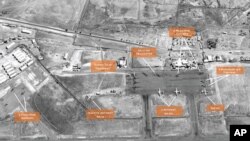The Satellite Sentinel Project (SSP) Tuesday released new images of an air base in Sudan’s Northern Kordofan State that it says corroborate reports that Sudan bombed two refugee camps in South Sudan last week. The Khartoum government has denied the bombings.
“These images show the El Obeid air base where there is a large gathering of military air power, including two AN 26 Antonovs,” said Nathaniel Raymond, head of the Harvard Humanitarian Initiative, which analyzes the satellite images.
He said the presence of the Antonov aircraft is important in light of eye witness reports of the November 10 attack on the Yida refugee camp. A similar attack was reported two days earlier at the Guffa camp.
“They match the description of the planes that allegedly attacked the two refugee camps in southern Sudan last week. Additionally, these planes on the strip at El Obeid are in range operationally of those camps. They could have made that flight and they are capable of performing a mission such as a bombing run,” Raymond said.
Growing air power
Last week, the SSP reported that the Sudanese Armed Forces were upgrading captured rebel air bases in Blue Nile State.
“They are improving the ability of newly captured airstrips to handle certain types of aircraft and to be able to handle multiple aircraft coming in or out of an airstrip at a time. The second thing we’re seeing…is the gathering of multiple types of aircraft at El Obeid,” he said.
The images identify the aircraft as ground attack fighters and helicopter gunships, in addition to the Antonovs.
Raymond said, “The question is will those joint strike fighters come into play and be used similar to the way the Antonovs have been used in terms of attacking ground targets?”
Southern response
The satellite Sentinel Project has also been watching developments on the South Sudan side of the border to see whether there’s a comparable build-up up of military forces.
“There is no comparable build-up that we have been able to see at this point,’ he said.
South Sudan is not believed to have anywhere near the number of military aircraft that Sudan has.
“Additionally,” Raymond said, “South Sudan has little roads or infrastructure to be able to bring forces to the front of the line. Whereas in the case of north Sudan, there has been significant build-up of infrastructure over the past few months along the border to be able to move troops and supplies.”
What next?
Raymond said, “I think the key now is for the U.N. Security Council to act. There have been a lot of statements, but policy related to south Kordofan, related to Blue Nile, international policy, has not changed all that much since the attacks began.”








